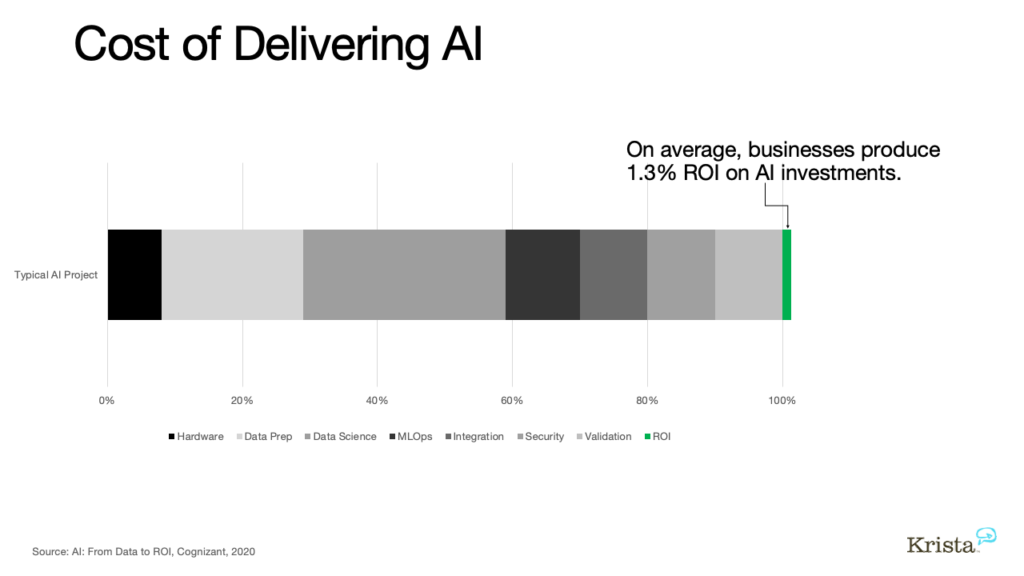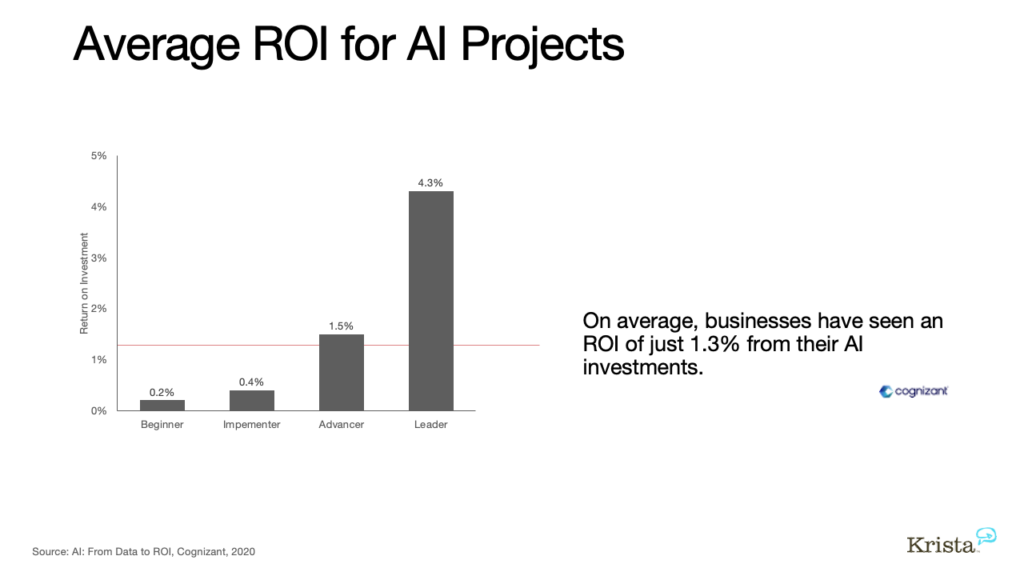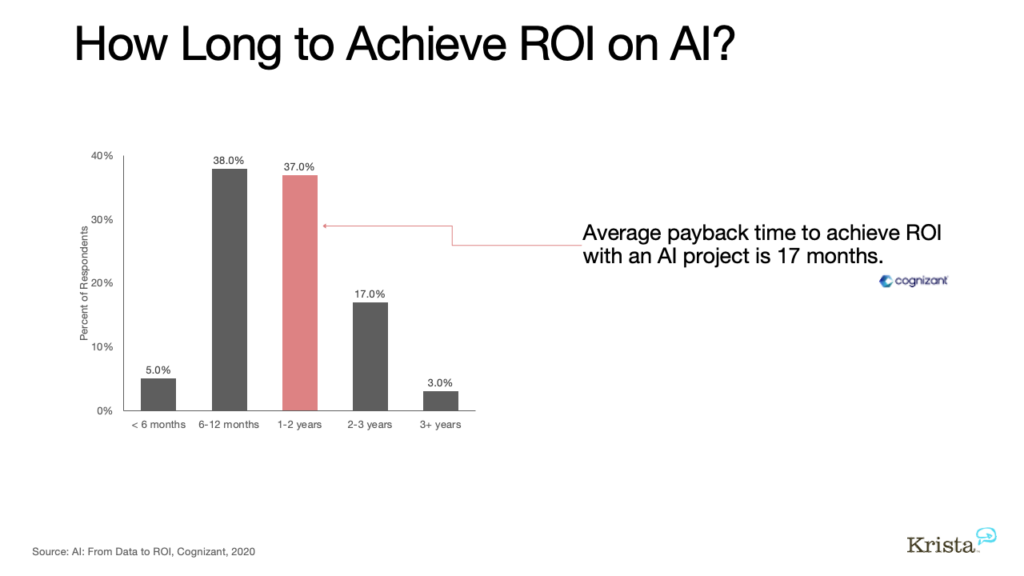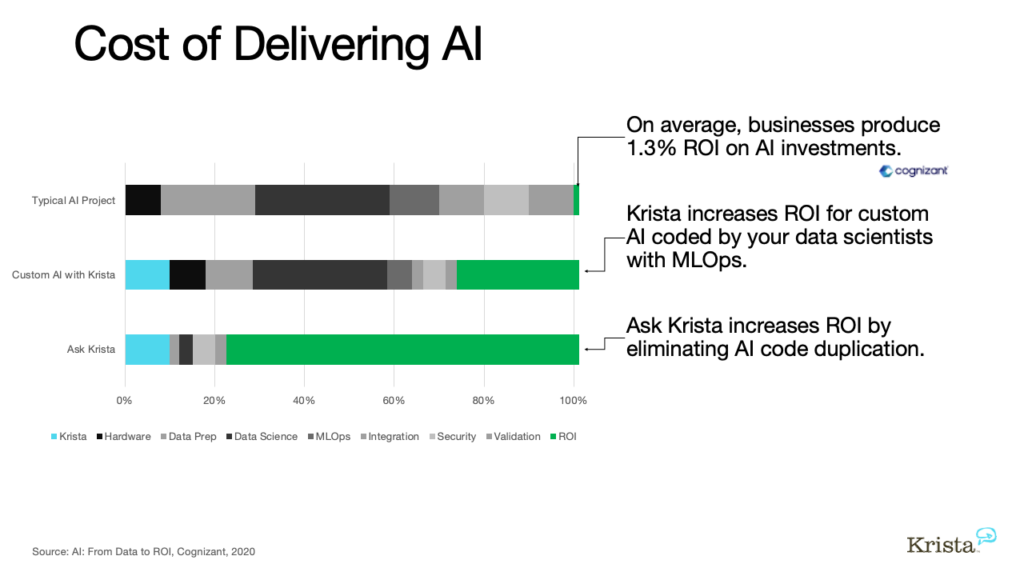Key Takeaways
- 7 common cost elements for AI projects
- Why AI projects achieve low ROI (1.3%) and why 85% of projects fail
- How to decrease AI project costs and implementation timelines to increase ROI

Download the eBook – “How to Decrease the Cost of AI ”
Many factors go into the cost of deploying artificial intelligence systems, and each business will have a different set of expenses depending on its needs. To understand the true cost of AI, it’s essential to break it down into its parts. This article provides some of the most common cost elements associated with AI systems and how to reduce your overall expenses without sacrificing value.
Worldwide revenues for artificial intelligence
According to the International Data Corporation (IDC) Worldwide Semiannual Artificial Intelligence Tracker, worldwide revenues for artificial intelligence (AI) software, hardware, and services will rise 19.6 percent year over year in 2022 to $432.8 billion. In 2023, the market is anticipated to surpass the $500 billion barrier. Artificial intelligence software on its own is forecast to total $62.5 billion in 2022, an increase of 21.3% from 2021, according to a new forecast from Gartner, Inc.
Artificial intelligence (AI) is a driving force behind digital transformation. Companies like Facebook, Amazon, Netflix, and Google reap immense value from custom AI solutions. This motivates virtually every commercial organization to try to implement an AI solution into their business processes. However, AI is an expensive and complex technology. Its ability to generate a meaningful return on investment (ROI) depends on your business, your goals, and the strategy you execute to achieve them. With the average ROI on AI investments at a mere 1.3%, the companies that can deliver and maintain an AI solution at lower costs than their peers are much more likely to create substantial competitive differentiation.
Common cost elements associated with AI solutions
So what does this mean for you and your business? Understanding the various costs involved in implementing AI solutions is imperative. If you’re thinking about deploying an AI solution or buying AI software, aligning your desired outcomes and ROI goals with artificial intelligence costs plus the software and infrastructure required to integrate it with your business are critical.
Part of what makes AI solutions expensive is that data scientists, programmers, and business experts have to create many systems from scratch.
Let’s look at the cost of implementing AI and some of the most common cost elements associated with a custom AI solution. AI project costs typically stem from hardware, data, data science, deployment automation, a.k.a “MLOps” or “XOps,” integration, validation, security, and continuous optimization.
Cost of hardware
Training AI models is computationally intensive, requiring powerful CPUs or GPUs and lots of RAM. Whether you invest in this hardware in-house or rent it from a cloud provider, it’s expensive and adds significant expense to your AI project relative to a traditional software project.
Cost of data
One of the most important cost factors associated with AI projects is the cost of data. To effectively train and deploy AI models, businesses need access to large amounts of high-quality data. This data can be expensive, especially if you need to purchase it from third-party vendors or allocate significant amounts of IT and subject matter expert time to organize it for a data science team. Ensuring that the solution has access to high-quality training data is critical for success; the adage “garbage in, garbage out” applies at least as much to AI as it does to any other software.
Custom solutions can be structured around high-quality data rather than generic training data. In most cases, a more in-depth AI initiative will require more time, which generates higher costs. For instance, building a complete AI analysis system can encompass several stages, from a minimum viable product (MVP) to a full product rollout. Furthermore, the AI development cost of storing and maintaining this data can also add up over time.
Preparing data for modeling
Typically, data preparation is an independent exercise that starts with an IT request for several data sets from several systems. Collecting and preparing this data often takes weeks or longer. Data preparation also includes data cleansing (removing outliers, filling in missing values, etc.), which can be a time-consuming and expensive process.
After IT generates the data, it must then be labeled and screened for relevance by both data engineers and business experts from each relevant domain/business unit. Many viable initiatives often lose steam here and die due to delays in the screening process since manipulating the data takes so long.
For some problems, the quality-controlled (“QC”) data then needs to be combined into a single “flat” dataset. Combining datasets can be a relatively simple process if the proper tooling is in place but is often time-consuming and error-prone when done manually with tools like Excel, especially when the data includes time-series or binary data.
Data science and training models
Most AI strategies plan to train their own models, some use tools, others write code, and some blend both.
Krista’s “don’t reinvent the wheel” integration-first strategy reduces the cost of training production-grade models by enabling users to rapidly experiment with AI. Before investing in creating new models from scratch, teams can experiment with AI created by other groups, offerings from cloud providers, or AI vendor solutions. Like “regular” software, reuse is a key component to delivering on time and under budget.
Cost of talent
Another cost to consider is the cost of talent. AI-based solutions require skilled data scientists, engineers, and other professionals with expertise in machine learning and artificial intelligence. These individuals can be expensive to hire, especially if you need to bring them on board full-time. Skilled senior data scientists can cost upwards of $150-250 per hour on a project basis or $500,000 full-time. You will also likely need to invest in ongoing training and research time to keep your team up-to-date on the latest AI breakthroughs.
Cost of deployment automation: MLOps / XOps
Since there are more moving parts in an experimental AI project than in a traditional iterative software project, the value of deployment automation is higher, but so are the cost and complexity. Traditional software requires that the right code is in the right place at the right time; AI requires that the right data, the right models, and the right code is in the right place at the right time. Underestimating this complexity has resulted in many teams underestimating the budget required to integrate AI with their business.
Integrating models with people and systems
Marketing campaigns have done a masterful job at distracting us from the simple fact that an AI or ML “model” is nothing more than a computer function or procedure. Accordingly, the intergenerational wisdom from successful enterprise software suggests that we should approach integrating AI solutions with people and systems in the same way that we have traditionally integrated people and systems. However, underestimating a culture change causes many software and digital transformation projects to fail because people don’t understand how to use complicated software. If they don’t understand, they don’t use it.
Advances in AI software and natural language processing (NLP) should enable systems to be easier to understand. NLP makes it easier to deliver AI capabilities to more of your people and will provide more accessible methods of integrating people and systems.
Validating AI with a “human in the loop”
Turning essential decisions over to AI and software causes fear. Many people will not use AI until they trust it. There isn’t a “gut” check. Trusting AI is critical for both initial adoption and ongoing model optimization (drift mitigation).
The lack of a human in the loop is the downfall of numerous artificial intelligence solutions. Many projects fail to offer a decision-maker-in-the-loop option to compliment nascent AI with human intelligence and judgment. People need visibility into the model’s performance in multiple real-world scenarios before they trust it enough to use it. Then, they will need even more validation before they trust it to operate autonomously.
Security costs
AI has more moving parts than traditional software, so it’s no wonder that the cost and complexity of securing it are higher too. Wise teams plan for this before they ask for a budget to start their projects and learn as much as they can from both other internal projects as well as from their peers.
Continuous optimization costs
Unlike traditional software, model performance degrades over time, requiring regular maintenance and optimization. Model maintenance costs are systematically underestimated and frequently cause AI solutions to go over budget or not stay in production very long.
The key to success is operationalizing the model optimization and management process. These processes should be built into how you do business and not an afterthought. Any business implementing ML needs to keep skilled data scientists available to address model drift, and their work needs to be rapidly validated and updated in production. This is where the investment in operationalizing model management (MLOps) creates big returns. Some examples include:
– Defining clear MLOps goals and objectives that align with business goals
– Implementing MLOps processes and tools into your business infrastructure
– Creating MLOps teams responsible for managing ML models throughout the lifecycle
– Automating measuring and monitoring ML model performance continuously
– Updating ML models as needed when improving their performance creates measurable business value
AI Implementation Challenges
AI Complexity
AI is expensive and hard to deploy because of its complexity.
Yes, it’s software, but the inherent “black box” nature of any AI system requires continued experimentation when a model isn’t learning something important from the data, as opposed to traditional software, in which the engineer tells the computer what to do. The paradox of “teaching” an AI system to learn something new from the same data is often accomplished at the expense of “un-learning” something it was able to learn before.
Compute Resources
Another challenge is that many businesses still don’t have the proper infrastructure to support AI initiatives. Cloud providers Google, Amazon, Microsoft, and Oracle, provide scalable data and compute capabilities but can be expensive. This includes everything from having the right data storage and processing capabilities to having enough computing power to run complex algorithms.
Lack of available skilled talent
Finally, there’s a lack of available skilled talent in the market. This is one of the biggest challenges facing businesses today as they try to build in-house teams or find external partners who can help them with artificial intelligence. There is talent available, but it comes at an increasing cost as AI development needs arise and the talent pool decreases. It’s best to align your available talent and the cost of acquiring talent to make sure you meet your ROI goals.
Why do AI Projects Fail?
According to a recent Cognizant report, the average ROI for an AI project is only 1.3%. Many more AI projects never achieve an ROI at all and ultimately fail. In fact, according to Gartner, 85% of AI projects fail.
Why?
Ineffective collaboration
Data scientists, software engineers, and business teams must work together to implement effective AI. It’s unavoidable. Working in silos results in failed projects and increases the cost of AI. The businesses that successfully provide scalable value are the ones that view the whole process as highly collaborative from start to finish. It’s not only about IT and data teams, either. Companies that successfully implement artificial intelligence at scale have a crucial element of their executive team that actively participates throughout the process. Maintaining enthusiasm for AI adoption will be difficult for most businesses without leadership support and collaboration.
Data Preparation Is a Problem
Since AI learns from data and doesn’t enjoy the benefit of human judgment, it requires clean, high-quality data. Customers and partners have difficulty working with dirty data. As a result, extensive data preparation is required—a procedure that involves cleaning dirty data, formatting it, and correcting anomalies and biases. Collecting, organizing, and cleaning data can consume up to 79 percent (79%) of a data scientist’s time. Because it is a time-consuming and difficult step in AI, it is frequently neglected, and decisions rely on AI-assisted human judgment. Nevertheless, data preparation is one of the essential components of the machine learning process, as it eliminates incorrect data that can lead to inaccurate deductions.
Lack of executive alignment
With the increased focus on artificial intelligence, data scientists are more in-demand than ever before. Even so, not everyone with the job title can deliver on these value propositions. While the market for such individuals is extremely competitive, many firms are unwilling to pay top rates for talent, resulting in them falling short in their attempts to deploy valuable ML models.
Losing focus on the business objective
An AI project must stay aligned with a significant business problem to have a chance to generate genuine commercial value. Many AI initiatives fail because they lose focus on a measurable corporate goal. In contrast, successful projects always have specific, quantifiable goals and track progress towards them throughout the project’s lifecycle.
How much does Artificial Intelligence cost?
Cost is an essential consideration for any digital transformation or software project. When deploying artificial intelligence to apps, executives may hyper-focus on the costs since it may be a company’s first attempt. IT leaders expect quick “wins” and ROI inside of a year, similar to SaaS projects. However, this isn’t easy to attain with AI. Deploying a model into production takes 17 months on average and costs an average of one million dollars ($1M). Then, once that model is deployed, the average production maintenance and support costs for that model are about 25% of the initial costs or $250,000.
Krista lowers the cost of delivering AI
Krista is a cost-effective way to deploy and operationalize machine learning and AI. Krista is an intelligent automation platform to help you orchestrate and operationalize business processes amongst your people, apps, AI, and, most importantly, data. Krista is easy to use and helps businesses reduce the cost of deploying AI. Krista provides systematic cost-cutting solutions for data collection, model training, MLOps, building trust, and reducing operational overhead in any AI or automation project. With Krista, businesses can successfully and cost-effectively implement AI and see a higher ROI on their artificial intelligence investments.
Data Collection and Cleansing
Krista is a cost-effective way to automatically collect and build machine learning training data. Krista provides your teams with a systematic method to automate processes amongst people, apps, and AI. By automating sales, finance, HR, DevOps, or supply chain processes, you can employ “Ask Krista” between steps in an automation. “Ask Krista” automatically collects data as your teams use intelligent automation and builds machine learning training data for you. Krista uses this data and “human in the loop” decisions to learn how and why decisions are made. As your people use Krista and teach her about your business, she and your people become more confident in AI. As you build trust in the AI and Krista increases her confidence, Krista can make decisions she is trained on so your people can move on to more complex business problems.
The cost and quality of data are crucial factors for an AI project. Quality data determines the success or failure of AI solutions. Krista reduces the cost of preparing high-quality data for machine learning because she is already connected to your systems and your people. Running processes through Krista enables her to collect data and understand the data’s context and quality. Since this data is already in Krista’s purview, modeling takes minutes, not months. Automatically collecting data with Krista increases your odds of achieving high ROI in a much shorter timeframe than an average AI project.
Training and deploying models
Training ML models from scratch can be prohibitively expensive and time-consuming, especially if you’re unsure which provider or technology will work best for your needs.
Not only do you need to worry about the cost of the hardware and software required to build your model, but you also need to factor in the time it takes to train and deploy that model. Even if you eventually find a technology that works well for your needs, you may have wasted valuable time and money experimenting with options that don’t pan out.
Krista’s “don’t reinvent the wheel” integration-first strategy enables you to rapidly experiment with offerings from Krista, cloud providers, and AI vendors before investing in creating new models from scratch. This approach reduces the cost of training production-grade models by up to 90% and can accelerate deployment time by 10x.
If you have data science teams building and maintaining custom ML models for your business, Krista’s bring your own model (BYOM) capability makes integrating models as easy as integrating systems. Krista’s integration and intuitive user interface reduce custom AI costs and facilitate reuse as well. Krista makes model integration easy using a nothing like code conversational-style integration studio. With Krista, you can simply import your model, and she’ll take care of the rest. She will make sure your data is prepped correctly and handle any errors that may occur, so you can focus on what’s important – using your model to improve your business.
Integrating models with people and systems
Krista is technology that understands people. Krista is an intelligent automation platform to help you integrate people, apps, and AI using natural language understanding (NLU). By using NLU, Krista removes user adoption issues and barriers by mimicking a “conversation” that your people are already used to.
For instance, you want to use a machine learning model but find it difficult to produce real value because it lacks an intuitive user interface fit for less technical people. By simplifying AI user interfaces, more people can use your models. More people interacting with your models can help you return more value to the business. Returning more value helps you maintain existing projects at lower costs and enables your teams to scale and expand.
Establishing enough trust in models to start using them (both for initial adoption and ongoing model drift mitigation)
With the advent of AI, there are many opportunities to improve businesses and lives, but people hesitate to trust AI capabilities and decisions. Rarely do leaders hand over decisions to machines without verifying results and building trust. Without building trust in the system and the ML models, even the simplest AI capabilities can take weeks or months to deliver value as people overcome the fear of models making incorrect decisions.
Krista provides your people with the power to build trust in AI over time. Krista dynamically includes “human in the loop” features for interacting with people, systems, and AI. Krista can optionally include a person in a process decision to leverage this person’s domain knowledge and experience. Eventually, the person builds enough trust in the AI that she will let Krista take on more work and make more autonomous decisions.
Security
Automating processes across people and apps requires access to many systems and data. Securing all of this information is essential. You must ensure people don’t have access to information they should not have access to and limit data leaking outside the organization.
Role-based data security is essential since not all information is privy to all users in your organization. Krista provides enterprise role-based access control at the data level that allows you to see only those pieces of information you’re allowed to see based on your role. Krista’s zero-trust security and enforcement model applies to the data inside the platform and data from external connections during orchestration. Whether the transaction is between a person, a system, or within platform services, the transaction must come from a trusted source and enforce role-based access rules.
Optimization
One of the biggest challenges for businesses deploying artificial intelligence is that they don’t have the skillset to maintain and optimize models effectively. Companies build in-house data science teams or purchase AI products to solve this problem, but these solutions are incredibly expensive, time-consuming, and have inherent limitations.
Krista offers a better way. Krista automatically tunes models using the data that flows through her automated processes, including the data that was updated or “labeled” by her users. This unique data visibility enables Krista to tune models, reducing the cost of ownership of AI while accelerating model performance automatically. As you optimize and streamline more processes, your people can remove themselves from “doing” things to “thinking” about how to solve more complex problems and help serve the business better.
Conclusion
Many AI projects fail because teams struggle to make AI technology work with the data available to their businesses. There’s been tremendous innovation in making AI technology work with small and medium-sized data sets; it just costs too much to deeply integrate those AI solutions to produce a meaningful return on investment for many traditional, non-digitally native businesses. Successful AI strategies need to address both improving the predictability of the business and doing so at a cost that creates an appropriate ROI.
It’s wise to consider all of the cost elements of an artificial intelligence project to produce a higher than average ROI. The major cost elements I have discussed in this article include:
- Data to train the models
- Training, deploying, integrating, validating, and securing the models
- Maintenance and optimization of production models
Successful AI projects create much more value with an integration-first strategy that focuses on developing the data and data science that doesn’t already exist rather than “inventing” a platform to deliver the AI to their teams.
Krista offers a unique combination of features that make her an ideal platform for achieving a high ROI on AI and automation projects. Please get in touch with us to discuss how Krista can integrate your people, systems, and AI so that you can create meaningful differentiation from your competitors.









